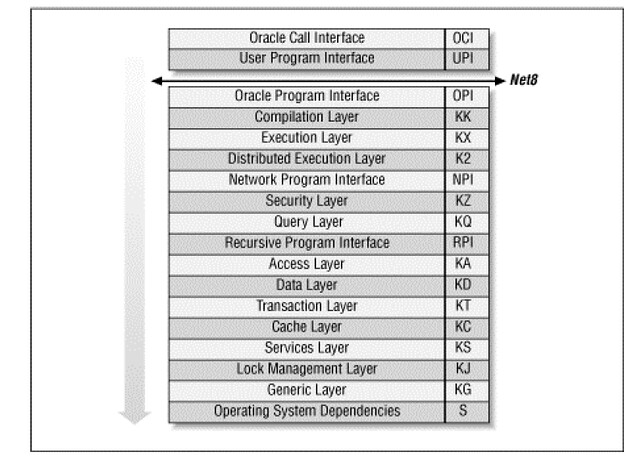了解Oracle内核代码层的作用
2011-09-13 22:43
495 查看
Oracle RDBMS Kernel 的代码分成多层次,如<Oracle8i Internal Services>一书所介绍的:

其中部分代码层的作用:
The cache layer (KC)
The cache layer manages the database buffer cache. It uses operating
system dependent facilities for data file I/O, provides concurrency control
facilities for local access to the cache buffers, and provides parallel cache
management (PCM) instance locking facilities for Oracle parallel server.
The other main responsibility of the cache layer is the control of redo
generation into the log buffer, and the writing of redo to the log files. The
cache layer also caches control file information.
To read blocks.
To update blocks in redo only mode.
The transaction layer (KT)
This layer is responsible for the allocation of transactions to rollback
segments, interested transaction list changes within data blocks, changes
to rollback segment blocks for undo generation, transaction control
facilities such as savepoints, and read consistency. The transaction layer is
also responsible for space management, both at the level of segment free
lists and at the level of tablespace extent allocation.
To update blocks with undo.
To check with the status of the transaction.
To manage recursive transactions for nested space operations.
The recursive program interface (RPI)
The recursive program interface is used to populate the dictionary cache
from the data dictionary. Row cache recursive SQL statements are
executed in a separate call context, but are not parsed and optimized in the
compilation layer.
Row Cache Layer
To read/update space dictionary information, where acutal updates happens by callbacks when row cache is flushed.
Recursive SQL
To read/update dictionary information.
File Layer
To create/drop/alter files in tablespace.
以上各代码层实现了Oracle Space Management 空间管理的主要功能。本文出自 “Ask Maclean Liu Oracle” 博客,请务必保留此出处http://maclean.blog.51cto.com/2923249/1278030

其中部分代码层的作用:
The cache layer (KC)
The cache layer manages the database buffer cache. It uses operating
system dependent facilities for data file I/O, provides concurrency control
facilities for local access to the cache buffers, and provides parallel cache
management (PCM) instance locking facilities for Oracle parallel server.
The other main responsibility of the cache layer is the control of redo
generation into the log buffer, and the writing of redo to the log files. The
cache layer also caches control file information.
To read blocks.
To update blocks in redo only mode.
The transaction layer (KT)
This layer is responsible for the allocation of transactions to rollback
segments, interested transaction list changes within data blocks, changes
to rollback segment blocks for undo generation, transaction control
facilities such as savepoints, and read consistency. The transaction layer is
also responsible for space management, both at the level of segment free
lists and at the level of tablespace extent allocation.
To update blocks with undo.
To check with the status of the transaction.
To manage recursive transactions for nested space operations.
The recursive program interface (RPI)
The recursive program interface is used to populate the dictionary cache
from the data dictionary. Row cache recursive SQL statements are
executed in a separate call context, but are not parsed and optimized in the
compilation layer.
Row Cache Layer
To read/update space dictionary information, where acutal updates happens by callbacks when row cache is flushed.
Recursive SQL
To read/update dictionary information.
File Layer
To create/drop/alter files in tablespace.
以上各代码层实现了Oracle Space Management 空间管理的主要功能。本文出自 “Ask Maclean Liu Oracle” 博客,请务必保留此出处http://maclean.blog.51cto.com/2923249/1278030
相关文章推荐
- 了解Oracle内核代码层的作用
- 内核代码宏中 do{...}while(0) 的作用以及宏中#和##的作用及典型应用
- 为AM335x移植Linux内核主线代码(1)了解dts
- 内核代码宏中 do{...}while(0) 的作用
- 为AM335x移植Linux内核主线代码(1)了解dts
- 为AM335x移植Linux内核主线代码——了解dts
- 为AM335x移植Linux内核主线代码了解dts
- 为AM335x移植Linux内核主线代码(1)了解dtb
- 内核模块编写代码使用的头文件以及头文件作用
- 为AM335x移植Linux内核主线代码(1)了解dtb
- Oracle Buffer-cache (数据高速缓存)作用概述
- oracle和sql server中回车符和换行符的sql代码
- Mac操作系统XNU内核(八)系统调用过程代码简单分析
- onvif学习笔记5:onvif框架代码初步了解
- iOS入门-了解这些常用单词,再也不怕看不懂苹果代码以及api接口了
- 淘宝--印风 专注于MySQL内核代码
- Oracle错误代码大全
- 深入php内核八(代码模块讨论)
- Oracle 左连接、右连接、全外连接、(+)号作用
- 需要再好好研究,如果有大神了解,请给予代码解释,谢谢
